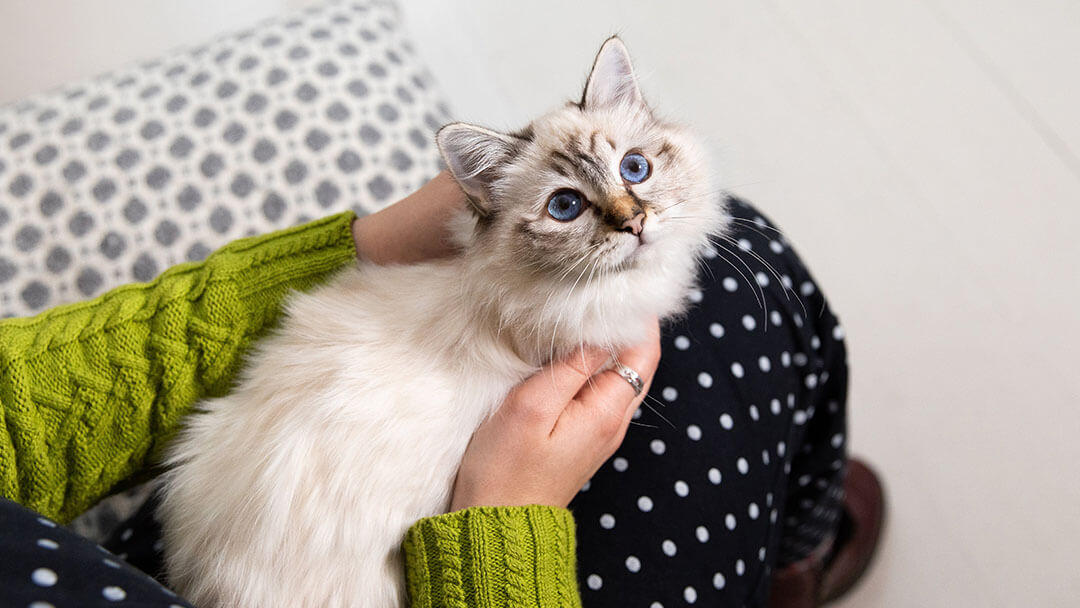
Just like us, our cats can suffer from eye infections. Their eyesight is precious so it’s important we notice when something’s not quite right.
There are different causes for cat eye infections, and they must be treated quickly so your cat doesn’t suffer with any pain or discomfort. See our guide to the types of infections below so you know what to look for if you suspect there’s something wrong with your cat’s eye.
Symptoms of a cat eye infection
There are some tell-tale signs of feline eye infections that you’ll notice. The most common are:
- Swollen eyelids
- Redness
- Cloudy eyes
- Runny or weepy cat eyes
- Abnormal amount of squinting or a sensitivity to light
- Rubbing and scratching at their eyes
- A lump by or near their eyes
- Bumping into things or looking more clumsy
- Third eyelid (in the inner corner of their eye) is more visible than usual
- Change in eye colour
If your cat has any of these signs be sure to contact your vet. Often it will be something simple like an eye infection but it’s always best to seek veterinary advice.
What are the common causes of eye problems in cats?
Some causes of cat eye problems are more common than others – scratches on the eyes or bacterial infections are common, while conditions like glaucoma are less common. Causes of eye disease include:
• Glaucoma in cats (increased eye pressure)
• Bacterial eye infections
• Upper respiratory and viral eye infections
• Conjunctivitis in cats (inflammation of the conjunctiva, a thin membrane that protects the eye)
• Physical injuries, like scratches
• Ulcers
• Allergies
• Cancer
If you think your cat could be suffering from one of these conditions, or you notice any unusual signs, contact your vet without delay.
What causes eye infections in cats?
There are a number of different causes of eye infections in cats. For example, an infection might be due to a virus, or it could be secondary to a cat scratch. Here are some of the most common causes:
Bacterial eye infections in cats
Bacterial eye infections can be passed from cat to cat or may occur secondary to a viral infection or an injury. Older cats and unvaccinated kittens are usually more susceptible to eye infections.
Upper respiratory and viral eye infections
Viruses can cause upper respiratory infections or cat flu which may result in a nasal discharge and sneezing in cats. A respiratory virus may also cause inflammation of the eyes, and an ocular (eye) discharge or watery eyes. Again, older cats and unvaccinated kittens are more likely to suffer from these infections and it’s always best to contact your vet if your cat is showing abnormal signs.
Scratches
Cats are curious creatures and sometimes this playful nature can result in injuries. They could potentially scratch their eye on a claw or something sharp in the home or garden, which could then become infected. If you think that your cat may have a scratch on their eye, contact your vet without delay as injuries to the eye can be serious and in rare cases even lead to loss of the eye.
Conjunctivitis
Conjunctivitis is inflammation of the conjunctiva, the thin, clear membrane that helps to protect the eye. It can be caused by bacterial or viral infections, as well as allergies.
Allergies
Infections can occur secondary to allergic conjunctivitis, and cat skin allergies can also cause watery eyes and itching. Talk to your vet if you think your cat may have an allergy as they can discuss how best to investigate your cat’s signs, including what diagnostic tests may be needed. Sometimes you may be able to make adjustments to your cat’s lifestyle to reduce their exposure to a particular allergen.
If you suspect that your cat has any of these issues, it’s really important to contact your vet. Your cat is likely to need treatment to ensure the condition clears up as quickly as possible and to avoid any lasting damage to their eyes.
How are cat eye infections treated?
There are a range of treatments for cat eye infections, and these usually come in the form of drops or ointment applied directly to the eye. The best course of action will depend on the diagnosis but whatever the cause, it’s important to follow your vet’s advice. This will give the best chance of a complete recovery.
Depending on the type of eye infection, the treatment could be anti-viral or antibacterial. Treatment could include:
- Oral antibiotics
- Eye drops
- Other topical solutions such as lubricants
- Pain relief
Your vet will diagnose the cause of the infection and then discuss a treatment plan with you.
Can cat eye infections be prevented?
Although there are ways to reduce the risk of your cat getting an eye infection. It is not possible to prevent cat eye infections completely. The best advice is to be proactive if you notice something is wrong, and you should also:
- Book regular checkups at the vet
- Keep annual vaccinations up to date
- Check your cat’s eyes at home for signs of cat eye infections (e.g., redness, swelling, watery eyes, eye discharge, sensitivity and squinting)
- Avoid overcrowding (especially with young kittens)
We hope our guide to cat eye infections was helpful. Next, see our guide on more cat illness symptoms you should look out for.









